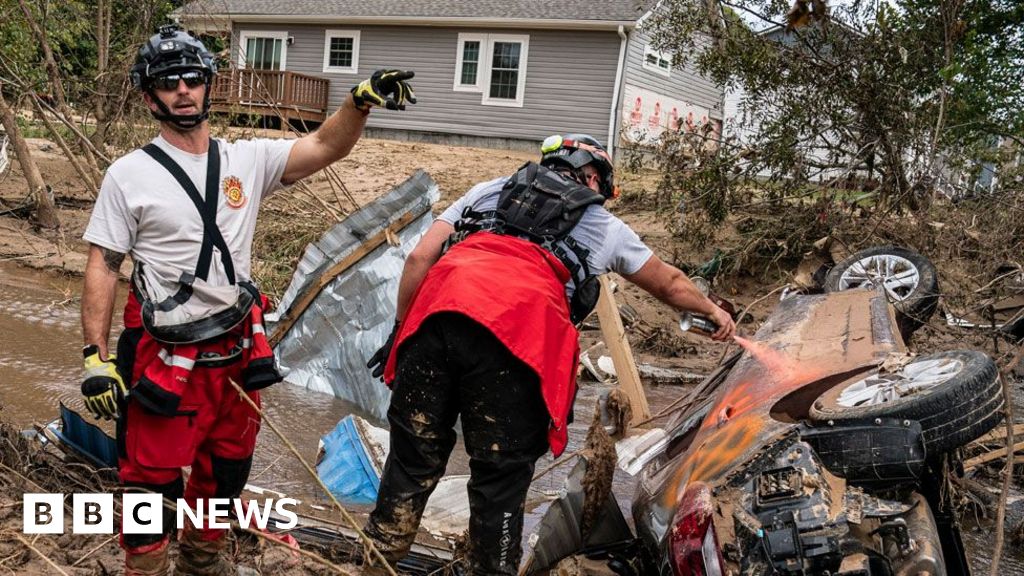Bussiness
Biden and Harris tour Helene storm havoc as death toll climbs

President Joe Biden and Vice-President Kamala Harris have travelled to south-eastern US states hit by Hurricane Helene, as the death toll from the storm climbed to 180.
Biden flew by helicopter over North and South Carolina to view the scale of the devastation.
Hundreds of people remain missing, with search-and-rescue teams struggling to reach remote areas.
Biden has deployed 1,000 active-duty soldiers to help 6,000 National Guard members and 4,800 federal aid workers already working across six states hit by the extreme weather.
Aid deliveries have been made by airdrops and mules. The US government has said the clear-up effort could take years.
Vice-President Harris, who is the Democratic presidential nominee, travelled to neighbouring Georgia on Wednesday.
Both North Carolina and Georgia are key swing states in November’s presidential election.
Republican presidential nominee Donald Trump took his own trip to Georgia earlier in the week to view the storm damage.
In North Carolina, where tens of thousands of residents remain without running water, Biden took an aerial tour of storm-ravaged western areas of the state.
“God willing, they’re alive,” he said, referring to reports of up to 600 people unaccounted for. “But there’s no way to contact them again because of the lack of cell phone coverage.”
The president is due to travel to affected communities in Florida and Georgia on Thursday, White House press secretary Karine Jean-Pierre said.
Helene hit the US last Thursday as a category four hurricane – the most powerful on record to strike Florida’s Big Bend – before weakening as it tore northwards.
According to CBS, almost half of the deaths caused by Helene have been in North Carolina alone, where six months’ worth of rain fell.
Five other states recorded deaths blamed on the storm: South Carolina, Georgia, Florida, Tennessee and Virginia.
Helene has proved to be one of the deadliest storms to hit the US in recent years. Its casualty list surpassed that of Hurricane Ian, which claimed at least 156 lives in 2022.
North Carolina’s mountainous areas saw particularly heavy rain that resulted in homes and bridges being washed away.
One emergency official in Buncombe County – which includes the hard-hit city of Asheville – said the state had experienced “biblical devastation”.
A volunteer involved in relief efforts told the BBC on Tuesday they knew someone who had “lost everything” in Hurricane Katrina in 2005, and had moved to Asheville, only to be devastated again nearly two decades later.
“Looks like she’s wiped out again,” the volunteer said. “She has no drinking water. No gasoline. The food in her fridge has rotted.”
Helene has also forced the closure of mines in Spruce Pine, a small town that is home to the world’s largest-known source of high-purity quartz.
In Tennessee, state authorities are investigating the operator of a plastics factory where 11 workers were swept away by rushing floodwaters on Friday. Two have been confirmed dead and four more remain missing.
Impact Plastics told CBS in a statement it had monitored weather conditions around its Erwin plant in north-eastern Tennessee, and dismissed employees “when water began to cover the parking lot and the adjacent service road, and the plant lost power”.
But in interviews with local outlets, employees said they were allegedly told to continue work in the factory until it was too late for a safe exit.
More than a million people in some of the affected states remained without power on Wednesday evening, according to monitoring site Poweroutage.us.
Initial analysis of the storm suggests human-induced climate change played a significant role in the amount of rainfall.
In parts of western North Carolina, records were smashed that had stood since the “Great Flood” of July 1916 – another hurricane-caused disaster.
The Atlantic hurricane season continues until the end of November.










